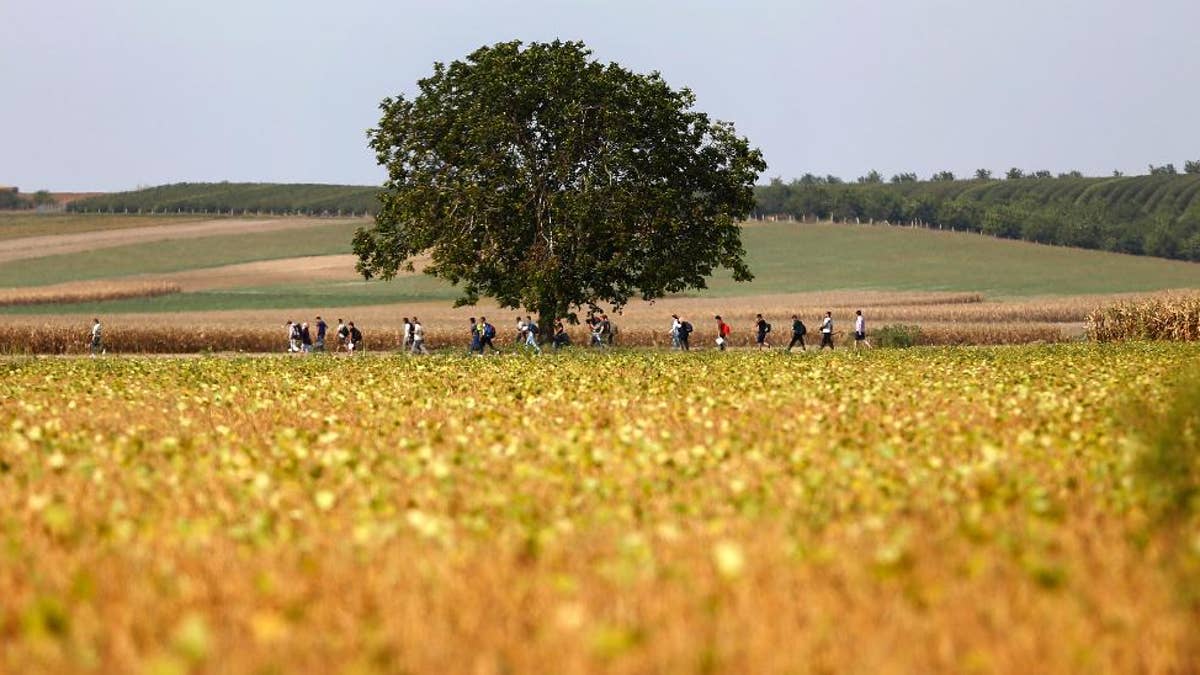
People make their way through fields at the border between Serbia and Croatia near Tovarnik, Croatia, Wednesday, Sept. 16, 2015. The first groups of migrants have started arriving in Croatia - a new entry point into the European Union after Hungary sealed off its border with Serbia with massive coils of barbed wire. (AP Photo/Matthias Schrader) (The Associated Press)
BERLIN – Refugees and migrants are making their way into Europe by the hundreds of thousands, adjusting their routes as some become too dangerous and others are blocked by authorities. Most want to get to Germany, Sweden and other northern European countries considered more welcoming than their counterparts to the south. Here's a look at how their paths to new lives are changing:
STARTING THE JOURNEY: There are two main routes into Europe. The first requires a long, dangerous boat trip from Libya to Italy. From there, travelers head north across open borders with France and Austria, mainly trying to get to Germany, Scandinavia and Great Britain. The other requires a much shorter, though still risky, boat trip from Turkey to Greece. From there, people walk, take trains or are driven through the Balkans as they try to reach Germany and other points north.
CHANGING ROUTES: Last year, some 170,000 refugees arrived by sea in Italy, while only 34,000 arrived in Greece. So far this year, 122,000 — a mix of Eritreans, Nigerians, Somalis, Sudanese and a small number of Syrians — have arrived in Italy. Meanwhile, 345,000 have arrived in Greece — 10 times the number who used the route in all of 2014. About 75 percent are Syrians fleeing civil war and the Islamic State, while the rest come from Afghanistan, Iraq and elsewhere. The switch happened for several reasons, but the Italy route was perceived as much more dangerous after several shipwrecks that killed hundreds. More than 2,800 people have died or disappeared trying to make it to Europe so far this year, the vast majority in the sea trying to reach Italy.
LEAVING GREECE: The vast majority of refugees arriving in Greece have been leaving by the simplest route — directly north through Macedonia and Serbia, which aren't in the European Union, before entering Hungary, which is. According to the European border control agency Frontex, the so-called Western Balkans route has seen a 1,374 percent increase in illegal border crossings detected this year through the end of August, compared to the same period last year — up to 155,170 from 10,525. Hungary is inside what's known as the Schengen area, a group of 26 countries that have abolished passport and other border controls. So once migrants get to Hungary, they can travel freely to other destinations in Europe. Or at least they could until Tuesday, when Hungary sealed its border with Serbia and began arresting people trying to breach the razor-wire barrier.
NEW PATHS: Following Hungary's move, migrants already in Serbia began moving west into Croatia, seeking a new entry point into the Schengen zone — either through another Hungarian border crossing or through Slovenia. About 150 people crossed into Tovarnik, Croatia, early Wednesday after they were bused to the Serbian border town of Sid on an all-night ride from Macedonia. Croatian Prime Minister Zoran Milanovic criticized Hungary's decision to seal its border, saying his country wouldn't do the same and would allow migrants to pass through Croatia.
BOTTLENECKS: Local authorities on Greece's eastern islands have struggled to cope with the numbers coming ashore and ferry them quickly on to the mainland. There have also been scuffles on the Greek-Macedonian border as police try to control the numbers crossing there. Budapest's main international train terminal, Keleti station, became a bottleneck for weeks until Austria and Germany agreed to ease the pressure by allowing in migrants who had gathered there. That, in turn, led to thousands of people arriving in the small Austrian border town of Nickelsdorf, overwhelming the Austrian authorities. At various points, train stoppages of varying lengths have prompted many migrants to try their luck on foot. Germany and Austria have sought to regulate the flows across their frontiers by introducing border checks but are still letting refugees through.
WHAT NEXT? That's anyone's guess. Those leaving Greece could choose to head through Albania north through Montenegro, Bosnia and Croatia to try and reach Slovenia or Hungary. They could try to cross the Adriatic from Albania and into Italy. Or they could take an easterly route, heading through Bulgaria and Romania and through Ukraine into Slovakia or Poland. A handful have made their way through Russia and then bicycled to a remote Arctic border post in Norway, though that's unlikely to become a popular route. Martijn Pluim, director of the International Centre for Migration Policy Development for Central and Eastern Europe, said his office is hearing that many may be moving by land through Turkey to head north through Bulgaria. "Where there was once one clear route, in the coming weeks you will get a wide variety of routes being tested and then being passed along by word of mouth — or word of WhatsApp," he said.
